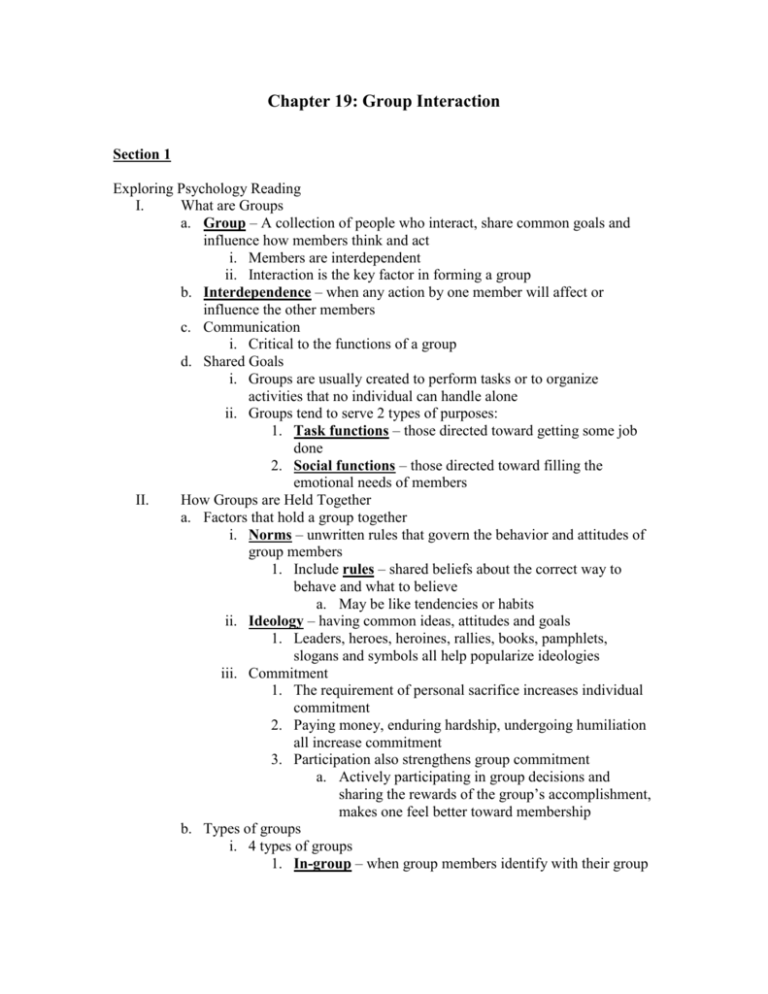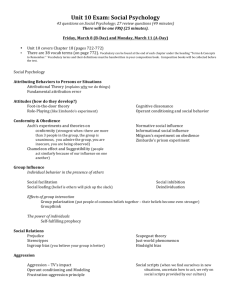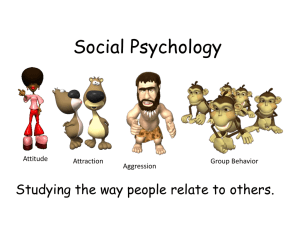Psych Ch. 19 Notes
advertisement

Chapter 19: Group Interaction Section 1 Exploring Psychology Reading I. What are Groups a. Group – A collection of people who interact, share common goals and influence how members think and act i. Members are interdependent ii. Interaction is the key factor in forming a group b. Interdependence – when any action by one member will affect or influence the other members c. Communication i. Critical to the functions of a group d. Shared Goals i. Groups are usually created to perform tasks or to organize activities that no individual can handle alone ii. Groups tend to serve 2 types of purposes: 1. Task functions – those directed toward getting some job done 2. Social functions – those directed toward filling the emotional needs of members II. How Groups are Held Together a. Factors that hold a group together i. Norms – unwritten rules that govern the behavior and attitudes of group members 1. Include rules – shared beliefs about the correct way to behave and what to believe a. May be like tendencies or habits ii. Ideology – having common ideas, attitudes and goals 1. Leaders, heroes, heroines, rallies, books, pamphlets, slogans and symbols all help popularize ideologies iii. Commitment 1. The requirement of personal sacrifice increases individual commitment 2. Paying money, enduring hardship, undergoing humiliation all increase commitment 3. Participation also strengthens group commitment a. Actively participating in group decisions and sharing the rewards of the group’s accomplishment, makes one feel better toward membership b. Types of groups i. 4 types of groups 1. In-group – when group members identify with their group 2. Out-group – everyone not a member of the in-group, will be rejected and can be hostile to the in-group 3. Primary group – group of people who interacts daily, face to face (family) 4. Secondary group – larger group of people with whom you might have more impersonal relationships (co-workers, classmates) c. Social Facilitation versus Social Inhibition i. Social facilitation - tendency to perform better in the presence of a group ii. Social inhibition – the times when one performs poorly in front of crowds iii. Many times how you perform in front of a crowd depends on what you are doing iv. The effect of a crowd on your behavior may also be a reflection of your concern about being evaluated d. Interactions within groups i. Group structure – the overall interconnection of the roles various members play in the group and how the roles are interrelated 1. Personal relationships between individual members, the rank of the member on a particular dimension and the roles they play 2. Role – behavior the is expected of an individual in a group 3. Role conflict – when roles conflict due to the change in environment or change in group membership ii. Decision Making 1. Group polarization – theory that group discussion reinforces the majority’s point of view and shifts group member’s opinions to a more extreme position a. But, if opinions of a group are equally split on an issue before a discussion, the group discussion usually then results in compromise 2. Groupthink – poor group decision making that occurs as a result of a group emphasizing unity over critical thinking iii. Communication Patterns 1. Sociogram – a diagram that represents relationships within a group, especially likes and dislikes of members for other members a. Helps psychologists predict how individuals will likely communicate with other group members iv. Leadership 1. All groups have leaders, those who embody norms, ideals of the group and represents the group to outsiders a. Initiates action, gives orders, make decisions and settles disputers; very influential 2. 3 Leadership styles a. Authoritarian i. Leader makes all the decisions and assigns tasks to group members b. Laissez-faire i. Leader is only minimally involved in a group’s decision making ii. Group’s goals not the leader’s are pursued iii. Group members make all the decisions c. Democratic i. Leader encourages group members to come to decisions through consensus ii. Viewed as supportive but not good decision makers Movie – The Wave Movie – The Outsiders Section 2 I. Group Pressure to Conform a. Conformity – involves any behavior that you engage in because of direct or indirect group pressure i. Solomon Asch found that people conform to other people’s ideas of the truth, even when they disagree, Asch Experiment b. Why do people conform i. According to some experiments: 1. Moscovici (1985) – Sometimes a minority view can come to win over a larger group a. By disagreeing with the majority view, a person can reduce the pressure that others feel to conform b. A minority dissenter may also serve an informational purpose by making others question whether the majority view is actually right c. When people hear a dissenting opinion, they are more likely to examine the issue more closely, which can lead to a better solution 2. Asch (1952) – participants conformed, they responded to match the other group member’s responses (although they may not have changed their actual belief) a. Video Clips i. ..\..\Video Clips\Group Conformity\Asch Conformity.flv ii. ..\..\Video Clips\Group Conformity\Elevator Psychology Conformity.flv b. This characterized the contrast between public behavior and private belief II. i. Compliance – when we respond to the request of another person without necessarily changing our beliefs ii. Foot-in-the-door technique – occurs when you get a person to agree to a relatively minor request 1. Salesmen Obedience to Authority a. Obedience – behavior in response to orders given by authorities which can be useful or destructive b. Gangs c. The Milgram Experiment i. Video Clips 1. ..\..\Video Clips\Group Conformity\Milgram Shock Experiment.flv 2. ..\..\Video Clips\Group Conformity\Stanley Milgram Go to 519.flv 3. ..\..\Video Clips\Group Conformity\Milgram Shock Experiment (Debriefing).flv d. The Zimbardo Experiment i. Webquest/Worksheet ii. Videos 1. ..\..\Video Clips\Group Conformity\The Stanford Prison Experiment pt. 1 of 3.flv 2. ..\..\Video Clips\Group Conformity\The Stanford Prison Experiment pt. 2 of 3.flv 3. ..\..\Video Clips\Group Conformity\The Stanford Prison Experiment pt. 3 of 3.flv iii. Stanford Prison Experiment http://www.prisonexp.org e. Cults/Manson f. Case Study: Your Stripes or Your Morality Section 3 I. Aggression a. What causes group violence i. L.A. Riots ii. Would these people have committed the same crimes in a different, calmer atmosphere b. What causes humans to act in ways that harm others c. Aggression – any behavior that is intended to cause physical or psychological harm. d. Theories of Aggression i. Biological Influences 1. Some animals are naturally aggressive; the response is an innate, biological reaction II. 2. Some psychologists say that humans have this same biological factor or DNA marker, so to speak a. BUT, they also say that one can NOT label aggression as caused only by biological factors ii. Cognitive Factors 1. Children learn through observation and imitation of their parents 2. Parents who use aggression (corporal punishment) to discipline their children may be teaching their children to use aggression 3. The classic (take this anyway you want) TV, movies, music, video games may be teaching aggressive behavior to children a. They grow immune to the horror of violence, accept violence as a way to solving problems, imitate the violence they observe and identify with certain characters that could be victims or victimizers b. Doesn’t take into account the exceedingly majority of the population that are encapsulated in all of the above mentioned media yet do not become aggressive. iii. Personality Factors 1. Certain traits like impulsiveness with little empathy and liking to dominate can turn a person into a bully 2. Aggressive people can be arrogant and egotistical 3. People can strike out at others as an affirmation of their superiority 4. Aggressive children tend to be aggressive adults iv. Environmental Factors 1. Frustration-aggression hypothesis – frustration or failure to obtain something expected leads to aggression a. Frustration doesn’t always lead to aggression, sometimes it leads to crying b. Revised to state that frustration leads to aggression only in certain circumstances Controlling Aggression a. One method to control aggression is through catharsis – releasing anger or aggression by letting out powerful negative emotions i. Lots of people believe that any expression of aggression is negative ii. Expressing aggression could lead to more aggression b. Punish children for violent behavior and cutting down on violence they observe c. Being taught to control their aggression i. Accept frustration and move on ii. React to disappointments in ways other than violence III. Altruism a. Altruism – helping another, often with a risk to oneself, for reasons other than the expectation of a reward b. Diffusion of Responsibility i. Kitty Genovese 1. http://en.wikipedia.org/wiki/Kitty_Genovese ii. James Bulger abduction and murder 1. http://en.wikipedia.org/wiki/Murder_of_James_Bulger iii. Diffusion of responsibility – the presence of others lessens an individual’s feelings of responsibility for his or her actions or failure to act iv. Bystander effect – an individual does not take action because of the presence of others c. Social Loafing i. Social loafing – the tendency to work less hard when sharing the workload with others d. Deindividuation i. Deindividuation – when individuals behave irrationally when there is less chance of being personally identified 1. People becoming involved in a riot 2. People in the crowd feel anonymous








